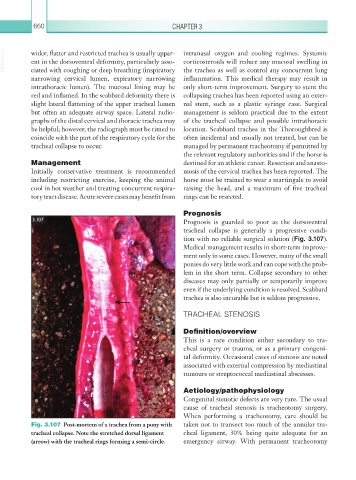Page 685 - Equine Clinical Medicine, Surgery and Reproduction, 2nd Edition
P. 685
660 CHAPTER 3
VetBooks.ir wider, flatter and restricted trachea is usually appar- intranasal oxygen and cooling regimes. Systemic
corticosteroids will reduce any mucosal swelling in
ent in the dorsoventral deformity, particularly asso-
ciated with coughing or deep breathing (inspiratory
inflammation. This medical therapy may result in
narrowing cervical lumen, expiratory narrowing the trachea as well as control any concurrent lung
intrathoracic lumen). The mucosal lining may be only short-term improvement. Surgery to stent the
red and inflamed. In the scabbard deformity there is collapsing trachea has been reported using an exter-
slight lateral flattening of the upper tracheal lumen nal stent, such as a plastic syringe case. Surgical
but often an adequate airway space. Lateral radio- management is seldom practical due to the extent
graphs of the distal cervical and thoracic trachea may of the tracheal collapse and possible intrathoracic
be helpful; however, the radiograph must be timed to location. Scabbard trachea in the Thoroughbred is
coincide with the part of the respiratory cycle for the often incidental and usually not treated, but can be
tracheal collapse to occur. managed by permanent tracheotomy if permitted by
the relevant regulatory authorities and if the horse is
Management destined for an athletic career. Resection and anasto-
Initially conservative treatment is recommended mosis of the cervical trachea has been reported. The
including restricting exercise, keeping the animal horse must be trained to wear a martingale to avoid
cool in hot weather and treating concurrent respira- raising the head, and a maximum of five tracheal
tory tract disease. Acute severe cases may benefit from rings can be resected.
Prognosis
3.107 Prognosis is guarded to poor as the dorsoventral
tracheal collapse is generally a progressive condi-
tion with no reliable surgical solution (Fig. 3.107).
Medical management results in short-term improve-
ment only in some cases. However, many of the small
ponies do very little work and can cope with the prob-
lem in the short term. Collapse secondary to other
diseases may only partially or temporarily improve
even if the underlying condition is resolved. Scabbard
trachea is also incurable but is seldom progressive.
TRACHEAL STENOSIS
Definition/overview
This is a rare condition either secondary to tra-
cheal surgery or trauma, or as a primary congeni-
tal deformity. Occasional cases of stenosis are noted
associated with external compression by mediastinal
tumours or streptococcal mediastinal abscesses.
Aetiology/pathophysiology
Congenital stenotic defects are very rare. The usual
cause of tracheal stenosis is tracheotomy surgery.
When performing a tracheotomy, care should be
Fig. 3.107 Post-mortem of a trachea from a pony with taken not to transect too much of the annular tra-
tracheal collapse. Note the stretched dorsal ligament cheal ligament, 30% being quite adequate for an
(arrow) with the tracheal rings forming a semi-circle. emergency airway. With permanent tracheotomy

